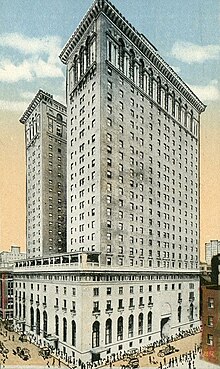| New York Biltmore Hotel | |
|---|---|
 (1917) | |
 Site of the hotel | |
| Alternative names | Biltmore Hotel |
| Etymology | Biltmore Estate in North Carolina |
| General information | |
| Status | Demolished (except for frame and basement) |
| Architectural style | Italian Renaissance Revival |
| Address | 335 Madison Avenue, Manhattan, New York City |
| Coordinates | 40°45′13″N 73°58′41″W / 40.75361°N 73.97806°W |
| Groundbreaking | March 1913 |
| Completed | December 1913 |
| Opened | December 31, 1913 |
| Closed | August 14, 1981 |
| Demolished | 1981–1983 (facade and interior) |
| Cost | US$5.5 million (equivalent to $170 million in 2023) |
| Height | 305 feet (93 m) |
| Technical details | |
| Floor count | 23–26 |
| Design and construction | |
| Architect(s) | Warren and Wetmore |
| Developer | New York State Realty and Terminal Company |
| Other information | |
| Number of rooms | 1,000 |
The New York Biltmore Hotel was a luxury hotel at 335 Madison Avenue in Midtown Manhattan, New York City. The hotel was developed by the New York Central Railroad and the New York, New Haven and Hartford Railroad and operated from 1913 to 1981. It was one of several large hotels developed around Grand Central Terminal as part of Terminal City. The Biltmore was designed in the Italian Renaissance Revival style by Warren and Wetmore, one of the firms involved in designing Grand Central. Although the hotel's steel frame still exists, the hotel itself was almost entirely demolished and replaced by an office building in the early 1980s.
The hotel building was variously cited as having between 23 and 26 stories. The hotel had a facade of granite, limestone, brick, and terracotta. Most of its floor plan was U-shaped, with a light court facing west toward Madison Avenue. In the basement was a reception room that led directly from Grand Central Terminal. The public dining rooms, including the Palm Court and main dining room, were at ground level. There was a roof garden above the sixth story, facing east toward Vanderbilt Avenue. There were additional ballrooms and meeting spaces on the upper stories. In total, the Biltmore had 1,000 rooms and suites; the fourth floor included a private entertainment suite called the Presidential Suite.
Following the construction of Grand Central Terminal, the New York Central started planning a hotel on the city block in the early 1910s, and it officially opened on December 31, 1913. The hotel was originally operated by Gustav Baumann, who died in October 1914. The hotel's manager, John McEntee Bowman, then operated it until his own death in 1931, affiliating the Biltmore with the Bowman-Biltmore Hotels chain. Realty Hotels Inc., a subsidiary of the New York Central, took over the hotel in 1934 and operated it for four decades. Paul Milstein acquired the hotel in 1978 and began demolishing the interiors immediately after the hotel closed on August 15, 1981. Despite protests from preservationists, Milstein gutted the Biltmore and converted it into an office building called Bank of America Plaza, which reopened in May 1984. Bank of America relocated in 2010 and the building became 335 Madison Avenue. Following another renovation in 2019, the structure became The Company Building, which in turn was renamed 22 Vanderbilt in late 2022.
